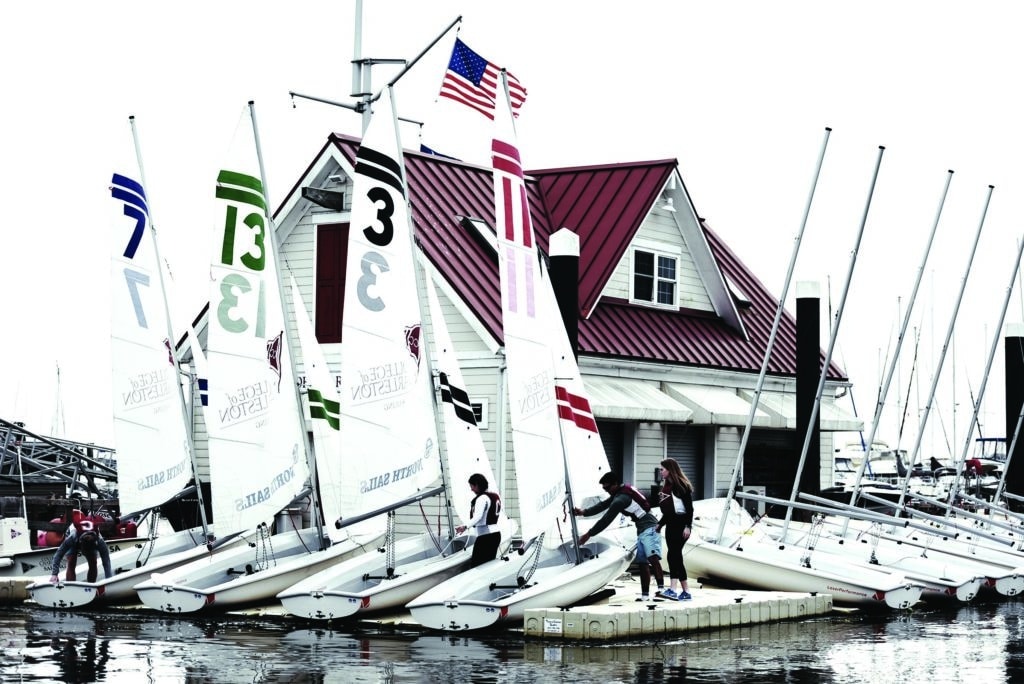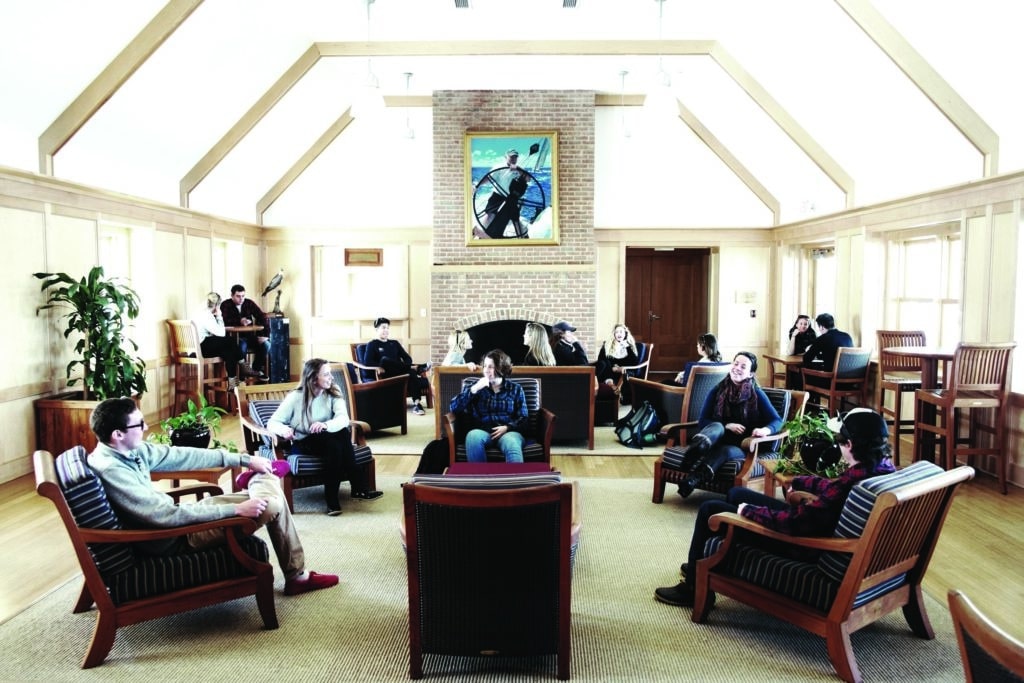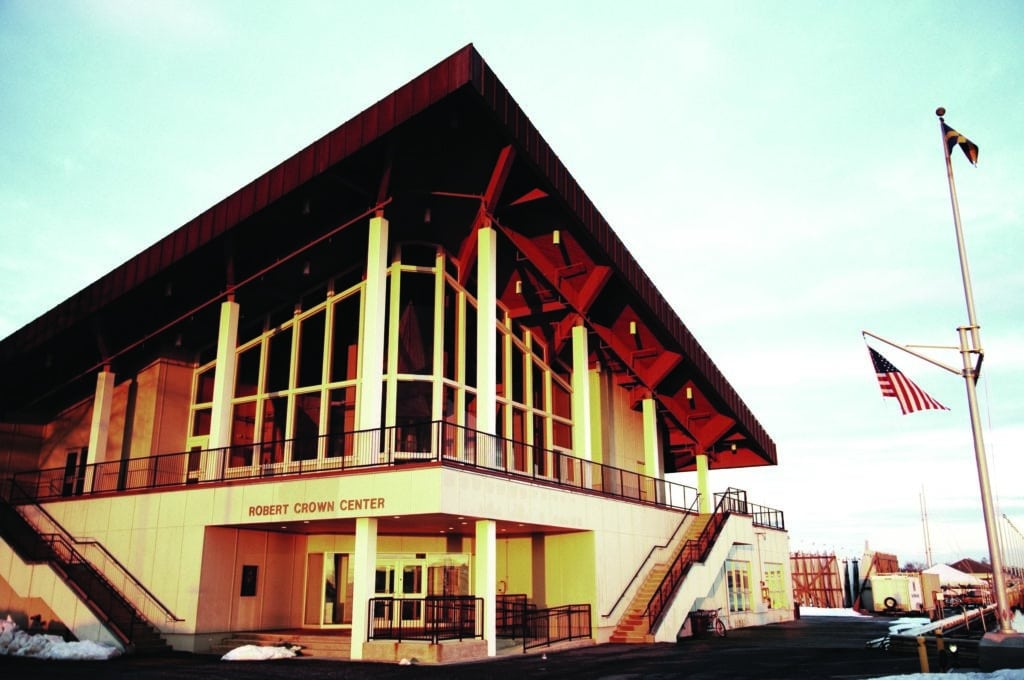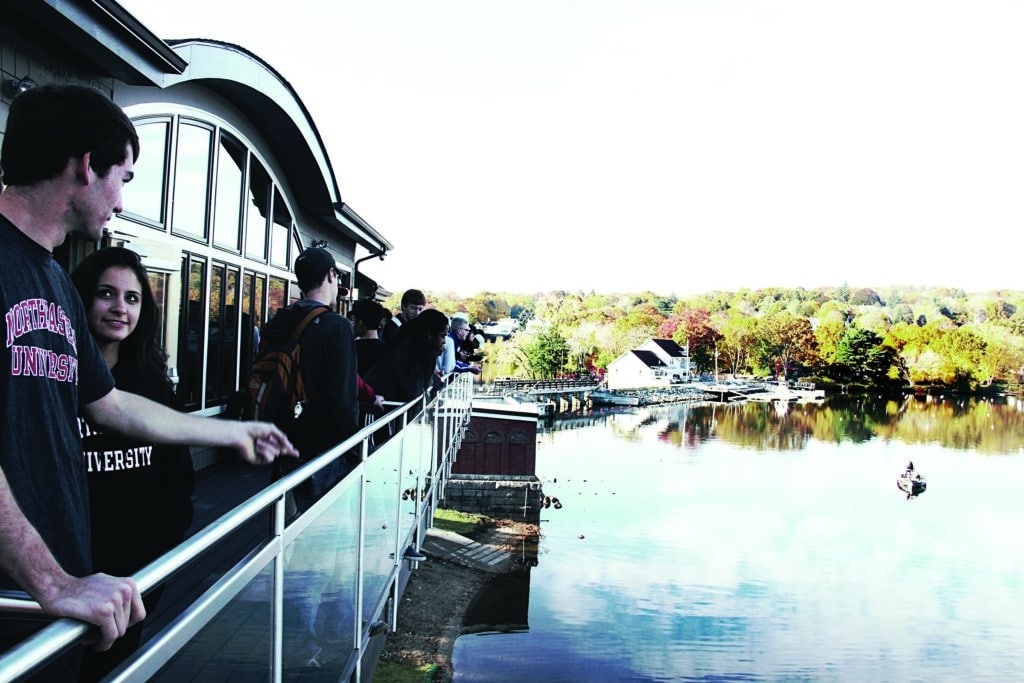Gone are the days of scrappy boathouses perched on docks with racks of musty dinghies reaching to the rafters. Today’s top college sailing digs boast lounges, locker rooms and training facilities, with an emphasis on energy efficiency and off-water learning. We won’t say that a better boathouse makes a better team, but these impressive structures have us wishing that sailing were a major.

College of Charleston, Chrisman Boathouse
Few college sailing venues strike fear into the hearts of visiting sailors at first sight like Cooper River, home of the College of Charleston Cougars. The team relishes it, knowing they have a home-field advantage matched by few other venues in the country. What they enjoy is a purpose-built facility that is home to an armada: 18 FJs, 18 420s, eight Lasers and 10 J/22s. Having the space to store them all is a luxury few programs can afford.
The Chrisman Boathouse is extremely efficient. A workshop allows for routine maintenance and major repairs to be done on-site. The classroom is an open-air space, which can’t be underestimated, given that team members are still getting tans in November. There is even a dedicated enclosed storage area for smelly boots.
The upstairs area is the coaches’ offices and sits high enough to give them a view of a sea breeze as it rolls into the harbor.
The Cougars travel more than anyone except Stanford, but the ability to have such varied practice conditions and a wonderful place to call home has certainly helped them vault to the top of the college sailing game.

St. Mary’s College, James P. Muldoon River Center
Located in historic St. Mary’s City, Maryland, St. Mary’s College is a public honors college that is home to one of college sailing’s historic sailing programs. Along with that distinction, the school boasts arguably the most beautiful sailing center in the country, the James P. Muldoon River Center. The River Center is the ultimate place to act as regatta host. The first floor is all business, sectioned off into private locker rooms, restroom facilities, offices, a classroom, a workshop and sail storage.
Creature comforts are found throughout the facility. The “Awesome Room,” on the second floor, is a great place to cozy up next to a fireplace on a cold day, or to simply come down and study. The windows look out over a porch where one can grab a chair and take in a sunset or watch students sailing.
The center is a LEED Silver-certified facility. A geothermal heat pump helps prevent the release of 270 metric tons of CO2 each year, while the implementation of water-conserving toilets and waterless urinals contributes to the college saving approximately 9 million gallons of water each year. The River Center is home to more than just the varsity sailing team. Like many other sailing centers, this is also a place that teaches sailing to students and the community. With a fleet of 54 dinghies and a small fleet of keelboats, those lessons run throughout the year. The center is also home to the college’s crew team and windsurfing club.
At the end of the day, it’s tough to beat the beauty that overwhelms visitors to this wonderful venue. Great sailing in beautiful surrounds has an allure that all of us can appreciate, and St. Mary’s College certainly got it right with this one.

U.S. Naval Academy, Robert Crown Sailing Center
The Robert Crown Sailing Center is aptly named, as it is also the crown jewel of college sailing. Between the intercollegiate dinghy team and the offshore team, one would be hard-pressed to find a weekend throughout the season when the Crown Center isn’t hosting an event. Most college sailors’ best memories and stories come from van rides or things that happen off the water, but for the U.S. Naval Academy, it almost always comes down to two words: Truxtun Umsted.
Few venues have the ability to host an event of the Trux’s magnitude: one division in 420s, one in FJs and two Laser divisions.
During the annual Truxtun Umsted regatta, four divisions of sailors from 20 schools call the Crown Center home for the weekend. With 150 to 200 sailors and coaches in one spot, things would typically become cramped. At the Naval Academy, however, space is abundant, and everyone is welcome to spread out. A large classroom on the first floor serves as a room for visiting teams and is conveniently located next to the large locker room. In the back of the first floor is the sail and equipment locker, where you’ll find the world’s largest collection of yellow Extrasport life jackets. The second floor features the coaches’ offices for both the dinghy team and the offshore team, as well as the dinghy team’s classroom. The classroom is a little awe-inspiring in that nearly every square foot of wall space is covered in official ICSA All-American certificates.
Adjacent to the Crown Center is the Santee Basin, home to more than 50 Lasers, 22 420s, 22 FJs, three Interclub dinghies, four Tech dinghies and three Vanguard 15s. There’s also a fleet of support craft in the way of Zodiac RIBs, Edgewater center-consoles and race-committee boats.
Every midshipman is required to pass basic sail training, and many of them use the opportunity to take up sailing while at the academy. To supplement this demand, the academy has quite a few large keelboats, including a fleet of Navy 44s, Colgate 26s, and an assortment of offshore raceboats.
The Naval Academy also houses the Intercollegiate Sailing Association’s Hall of Fame. With panoramic views of the Severn River, the room is home to the major awards of college sailing. The names of every national champion and All-American are etched in plaques and trophies from the past century.
The Naval Academy sailing team was once the most dominant team in the country. In one stretch, they won the Fowle Trophy for an unmatched seven straight years. During that time they won 13 national championships and accumulated more All-American honors than most teams have in their entire existence. The Crown Center will always be known as one of the great homes of college sailing and arguably its most accomplished program.

Massachusetts Institute of Technology, Walter C. Wood Sailing Pavilion
As the “birthplace of college sailing,” the Massachusetts Institute of Technology Walter C. Wood Sailing Pavilion has long been a leader in college sailing, and to this day it continues to offer high-caliber events as well as sailing opportunities for students of the institution. Built in 1935, it is the oldest university sailing pavilion in the world.
The facility sits on a dock on the Charles River, with a multilevel building that has boat storage, offices, classrooms and workshop facilities. The rooftop doubles as an outstanding observation platform for regattas. An extensive dock expands off to both sides of the building and is home to 30 Tech dinghies, 24 FJs, 24 Fireflies, six 420s, six Lasers, six Cape Cod cat boats, one Mach 2 foiling Moth, one RS400, eight sailboards and six safety launches.
Through the years, the pavilion has been the gracious home of more than just the MIT sailing team. Sailing master Fran Charles allows otherwise “homeless” sailing teams to use the facility, which has had a profound impact on the growth of teams in the New England area. When the MIT team practices, it is common to have other teams from around the area join. These “mega-practices,” when supplemented with Harvard’s fleet just down the river, are legendary in their own right, and often more competitive than weekend regattas. NEISA schools and their alumni love to brag about the quality of racing in their conference, but without a doubt, it would be nowhere near as legendary if not for MIT’s towering presence in the community.
The Sailing Pavilion has long been a standout not only for hosting sailboat racing but, more importantly, for sailing instruction. Thousands of individuals can credit MIT’s Walter C. Wood Sailing Pavilion with having been the place where they learned how to sail. Except in winter, sailing lessons are given almost daily, and everyone is encouraged to participate. It’s hard to beat sailing around with friends against the backdrop of the Boston skyline.

Tufts University, Bacow Sailing Pavilion
The new Bacow Sailing Pavilion truly is a sight to behold. Three stories tall with indoor storage for the team’s fleet of 24 Larks, the facility has everything the Jumbos need.
One of the best features is something all visiting teams and spectators enjoy: a 450-square-foot observation deck. The experience of viewing a regatta from 30 feet above the ground is awesome.
The old facility certainly served the team well over the years, as Jumbo sailors have gone on to win four College Sailor of the Year awards and an astounding 47 world championships; some have even become Olympians. Team members have always been responsible for boat maintenance and upkeep, and through the years the sailors have taken great pride in the many lessons learned. They still have many stories to tell about pastimes at the old boathouse. The new facility promises to do even more for the team.
Old Dominion University
I may be a little biased, but proudly so. The Old Dominion Sailing Center sets itself apart from facilities at most other schools in that it is strictly for the use of the varsity sailing program. In 2002, the Monarchs moved into their new facility. The center features two matching locker rooms and a large classroom that doubles as a study area for team members. The coaches’ lives also improved with a larger shop, as well as office space to accommodate three coaches on staff.
The sailors are spoiled by a large hangar-style boathouse that allows all 18 of the program’s FJs to be left fully rigged. Sure, they may have to ease some halyard tension before walking away, but the ability to launch or put away the entire fleet in less than 10 minutes is remarkable.
University of Wisconsin, Hoofer Sailing Club
Overlooking Lake Mendota, the Hoofer Sailing Club definitely scores high on the “neat” factor. Unlike other teams with stand-alone facilities, the headquarters are inside Memorial Union in the heart of campus. Although the team doesn’t sail for half the year due to ice, the Badgers know how to enjoy the outdoors when the weather warms.
The Hoofer Sailing Club is much more than just a place to host a regatta or practice. It also has one of the best workshops in the game. Located in the bowels of the student union, the workshop has everything an aspiring do-it-yourselfer could want or need. Sailors have the ability to learn all about boat and engine maintenance, as well as to work on a variety of other projects during their downtime.
Coaches across the country know Wisconsin is always a team to watch out for, with talented sailors who simply love what they do. That attitude of enjoyment makes them excellent hosts, as evidenced when they hosted the 2010 ICSA National Championships. It may have been a light-air week, but for me, watching a regatta has never seemed more relaxing than when sitting outside next to a biergarten with local live music playing.









